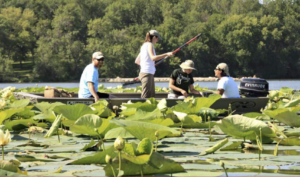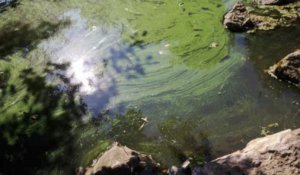Getting into Soil and Water 2020

Have you ever gone to the lake and been greeted by unwelcome, smelly scum? Algae are terrestrial and aquatic organisms that produce energy through photosynthesis. They are a primary food source for other organisms and produce oxygen during their photosynthetic process. Rapid growth of algae, called algal blooms, occurs naturally across aquatic landscapes. However, there is a group of bacteria called cyanobacteria that has similar photosynthetic characteristics and functions in aquatic systems. Cyanobacterial blooms, called harmful algal blooms (HABs), are capable of producing dangerous toxins.
HABs are increasing in frequency worldwide. Here in the Midwest, changing climate conditions and increased nutrient loss (particularly phosphorus and nitrogen from agricultural systems or municipal sewage wastes) feed these algal blooms, creating negative impacts for aquatic life, public health, recreation, and drinking water quality management.
The pressing threat of HABs has led to increased research activity across many governmental and non-governmental programs, including the United States Geological Survey’s (USGS) Water Resources Mission Area. The Water Resources Research Act of 1964 created
a national network of Water Resources Research Institutes (WRRI), administered by USGS. In 2017, nine WRRIs in the Upper Mississippi River Basin aligned their research focus on HABs with the intent to gain, share, and synthesize knowledge on HABs in order to develop a regional product.
In 2018, with the support from the North Central Region Water Network (NCRWN), this regional coordination initiative led to the formation of a twelve-state team partnering WRRIs and Cooperative Extension to assess current HABs outreach and education efforts and establish uniform recommendations for the North Central Region. Cooperative Extension, also a part of the Land-Grant University System, is often on the front lines of communication research-based information to stakeholders. Using HABs as the focal issue, this team sought to inventory current WRRI-sponsored HABs research, inventory and identify gaps in Extension HABs publications and outreach efforts, and bring Extension and WRRIs together to assess programming needs.
After completing these inventories, the partnership identified five key topic areas in which to develop messaging for outreach materials:
- General HABs Knowledge. There is a need across the region to provide basic information on HABs. The products developed with this messaging are a “one-stop shop” for high-level HABs information. For states that are lacking in resources or public demand to provide more in-depth HABs information on specific topics, these products provide a base-level introduction to HABs.
- Identifying, Monitoring, and Treating HABs. Identifying, monitoring, and treating HABs are the logical next step for those in regions experiencing HABs. Those that see algal blooms will wonder if they are harmful algae or nuisance algae; water professionals and citizen groups like watershed coalitions and lake associations will be interested to know how they can control them. There are many resources that exist outside of Extension for identifying, monitoring, and treating HABs, particularly those offered by the Environmental Protection Agency and state agencies (who typically house a monitoring program for HABs or beach closures). Extension products can provide information specific to identifying, monitoring, and treating HABs that then refer people to these additional resources.
- Human Health and HABs. Both humans and domestic animals can come into contact with HABs, either through drinking contaminated water, eating fish, or recreating in lakes and rivers. Ingesting toxins produced by some HABs can lead to neurological problems, including respiratory distress and convulsions (neurotoxins), and gastrointestinal illnesses, liver, and kidney diseases (hepatotoxins). Contact with the skin (dermatoxins) can cause rashes and skin irritation. In addition to these acute effects, the effects of chronic exposure to cyanotoxins are difficult to study and not well understood. Human health concerns may be a key entry point for raising concern among many populations and policymakers.
- Animal Health and HABs. In some states, like North Dakota and Missouri, the primary public concern regarding HABs resulted from pet and livestock deaths from drinking or coming into contact with algal toxins. While humans might attribute their symptoms to other common illnesses, animals that ingest toxins may suffer sudden death from acute toxicity, placing more importance on preventing animals from coming into contact with blooms.
- Landscape Nutrient Management Practices and HABs. Human-derived sources of nutrients are a primary contributor to the development of HABs in aquatic ecosystems. Agricultural, or non-point source systems, are inherently leaky systems, and their impacts on aquatic systems are increased by climate change. Forecasting how nutrients leave the landscape is a challenge because of the unpredictability of weather conditions. However, the use of nutrient management practices can minimize nutrient loss from agricultural systems and benefit farmers and those downstream. Nutrient management practices that address both nitrogen and phosphorus losses are a primary prevention strategy for HABs.

Partnership members self-selected into sub-groups to develop key messaging for each of three audiences: the general public (any person who might encounter HABs); the engaged citizen (individuals interested in taking action with HABs knowledge learned); and water professionals (those actively working in professions that may deal with the prevention, identification, treatment, or monitoring of HABs). Additionally, the team made recommendations for products to develop for use in Extension and outreach programming. For this list, as well as the comprehensive package of key messaging, please refer to the white paper available at https://northcentralwater.org/files/2019/11/HAB-11-22-2019. pdf.
This comprehensive and partnered approach to tackling one of the region’s most pressing water issues is a good start to building a culture of collaboration among the major players in water research and education. It is important to engage with the diverse breadth of interested parties: soil and water conservation district staff, agricultural and environmental engineers, local watershed groups, county conservation boards, municipal and county staff, farmers and ranchers, neighborhood associations, and citizen scientists, to name a few. Partnering to solve water resource issues in our states is the best path forward.
Melissa Miller
Former Associate Director for the Iowa Water Center